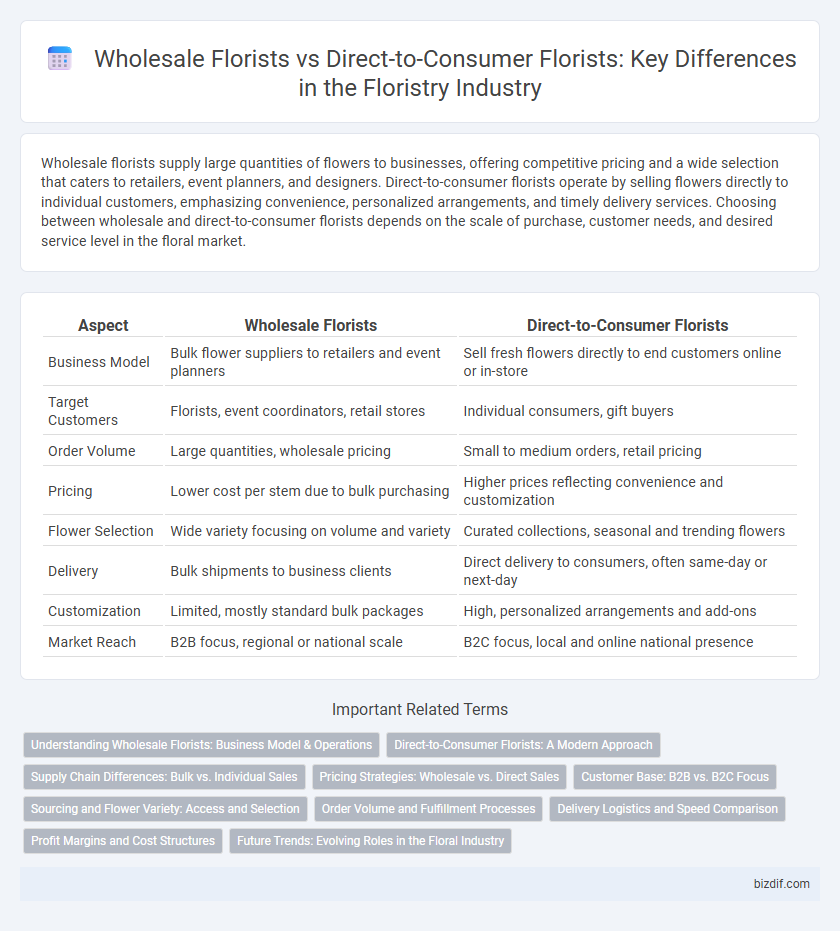Wholesale florists supply large quantities of flowers to businesses, offering competitive pricing and a wide selection that caters to retailers, event planners, and designers. Direct-to-consumer florists operate by selling flowers directly to individual customers, emphasizing convenience, personalized arrangements, and timely delivery services. Choosing between wholesale and direct-to-consumer florists depends on the scale of purchase, customer needs, and desired service level in the floral market.
Table of Comparison
| Aspect | Wholesale Florists | Direct-to-Consumer Florists |
|---|---|---|
| Business Model | Bulk flower suppliers to retailers and event planners | Sell fresh flowers directly to end customers online or in-store |
| Target Customers | Florists, event coordinators, retail stores | Individual consumers, gift buyers |
| Order Volume | Large quantities, wholesale pricing | Small to medium orders, retail pricing |
| Pricing | Lower cost per stem due to bulk purchasing | Higher prices reflecting convenience and customization |
| Flower Selection | Wide variety focusing on volume and variety | Curated collections, seasonal and trending flowers |
| Delivery | Bulk shipments to business clients | Direct delivery to consumers, often same-day or next-day |
| Customization | Limited, mostly standard bulk packages | High, personalized arrangements and add-ons |
| Market Reach | B2B focus, regional or national scale | B2C focus, local and online national presence |
Understanding Wholesale Florists: Business Model & Operations
Wholesale florists operate by purchasing large quantities of flowers directly from growers and distributing them to retailers, event planners, and other businesses, enabling cost efficiency through bulk buying. Their business model emphasizes maintaining strong supplier relationships, managing extensive inventory, and providing diverse floral varieties to meet professional demand. Operationally, wholesale florists focus on rapid turnover, temperature-controlled storage, and logistical precision to ensure flower freshness and timely delivery.
Direct-to-Consumer Florists: A Modern Approach
Direct-to-consumer florists leverage e-commerce platforms to deliver fresh, customized floral arrangements directly to customers, bypassing traditional supply chains. This modern approach emphasizes convenience, personalized service, and rapid delivery, appealing to tech-savvy consumers seeking unique and timely floral gifts. By controlling the entire process from sourcing to delivery, direct-to-consumer florists ensure quality and freshness while adapting quickly to market trends.
Supply Chain Differences: Bulk vs. Individual Sales
Wholesale florists operate on a supply chain optimized for bulk sales, sourcing large quantities of flowers from growers and distributing them to retailers or event planners, which reduces per-unit costs and ensures consistent availability. Direct-to-consumer florists manage a supply chain tailored for individual sales, emphasizing quality control, customization, and rapid delivery to maintain freshness and meet specific customer preferences. These fundamental differences impact inventory management, pricing strategies, and delivery logistics across the floristry industry.
Pricing Strategies: Wholesale vs. Direct Sales
Wholesale florists typically offer significantly lower prices per stem by selling in bulk to retailers and event planners, leveraging economies of scale to reduce costs. Direct-to-consumer florists often implement premium pricing strategies to cover additional expenses such as personalized arrangements, same-day delivery, and branded packaging. Price sensitivity varies between these models, with wholesale buyers prioritizing volume discounts and direct customers valuing convenience and customization.
Customer Base: B2B vs. B2C Focus
Wholesale florists primarily serve a B2B customer base, supplying bulk flowers to retailers, event planners, and floral designers, enabling large-scale purchases and consistent inventory replenishment. Direct-to-consumer florists operate within a B2C framework, focusing on individual customers seeking customized floral arrangements for personal occasions, often emphasizing convenience and personalized service. The distinct customer base shapes each florist's marketing strategies, pricing models, and product offerings to meet specific client needs and buying behaviors.
Sourcing and Flower Variety: Access and Selection
Wholesale florists source flowers in large quantities directly from growers, offering a vast selection of fresh, seasonal blooms at competitive prices ideal for retail and event professionals. Direct-to-consumer florists curate flowers from a limited number of suppliers or local farms, providing carefully selected and often unique varieties with personalized arrangements. Access to flower variety in wholesale markets ensures diverse options for bulk purchasing, while direct-to-consumer florists focus on exclusive, high-quality blooms tailored for individual customers.
Order Volume and Fulfillment Processes
Wholesale florists typically handle large order volumes, supplying bulk flowers to retailers and event planners, which requires efficient, large-scale fulfillment processes including advanced inventory management and rapid distribution logistics. Direct-to-consumer florists manage smaller, personalized orders that demand meticulous attention to detail in packaging, same-day delivery options, and often integrate technology for real-time tracking and customer engagement. The distinct fulfillment models of wholesale and direct-to-consumer florists reflect their different scale and customer service priorities, impacting order processing speed, cost-efficiency, and customization capabilities.
Delivery Logistics and Speed Comparison
Wholesale florists typically distribute large volumes of flowers to retail shops and event planners, enabling faster bulk deliveries through established supply chains and regional hubs. Direct-to-consumer florists emphasize same-day or next-day delivery services, leveraging localized inventory and streamlined order processing for rapid doorstep fulfillment. Delivery logistics for wholesale florists prioritize efficiency and capacity, while direct-to-consumer florists focus on speed and customer convenience.
Profit Margins and Cost Structures
Wholesale florists benefit from lower cost structures due to bulk purchasing and reduced packaging expenses, enabling higher profit margins on large volume sales. Direct-to-consumer florists face higher operational costs including marketing, delivery, and custom arrangements, which compress profit margins despite premium pricing. Understanding these distinctions helps businesses optimize pricing strategies and manage cash flow effectively within the floral industry.
Future Trends: Evolving Roles in the Floral Industry
Wholesale florists are integrating advanced supply chain technologies to enhance efficiency and meet growing demand from direct-to-consumer florists, who leverage e-commerce platforms and personalized delivery services to cater to individual customers. The increasing use of AI-driven inventory management and sustainable sourcing practices is reshaping the floral industry's operational landscape. Future trends indicate a hybrid model where collaboration between wholesale and direct-to-consumer florists will drive innovation and customer satisfaction.
Wholesale florists vs Direct-to-consumer florists Infographic

 bizdif.com
bizdif.com